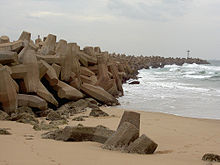Breakwater (hydraulic engineering)

Breakwaters have hydraulic especially protective function: to prevent the destruction of boats and banks by converting the energy of the waves by dissipation .
A distinction must be made between floating and firmly established breakwaters. The most important representatives of the latter are jetties in front of port areas and groynes on sea and river banks. In addition to embankments fortified with revetments , breakwater blocks (mostly made of concrete ) such as tetrapods or dolomises are used for fastening to endangered bank areas . Furthermore Riffbälle and artificial reefs used.
The breakwaters in the marina of the Olympic Village in Barcelona were built in 1988-92 for the first time using a special construction method. Wave dynamics experiments at the end of the 1990s confirmed that breakwaters that do not reach the water surface and are not continuously attached to the entire pier are more efficient than geometrically symmetrical breakwaters.
The most important floating breakwater is the concrete pontoon on the outer edge of marinas exposed to swell (e.g. in rivers or in small bays): Due to its large inertia, it effectively dampens swell and thus prevents damage to boats from swell.
See also
literature
- Harold and Ronald Wagner: Planning of stone embankments to protect against waves . In: Hansa , Heft 8/2013, S. 87-92, Schiffahrts-Verlag Hansa, Hamburg 2013, ISSN 0017-7504
- Hans-Dieter Clasmeier: A look back at 150 years of port construction technology . In: Hansa , jubilee edition January 2014, p. 126–142, Schiffahrts-Verlag Hansa, Hamburg 2014, p. 139/140
